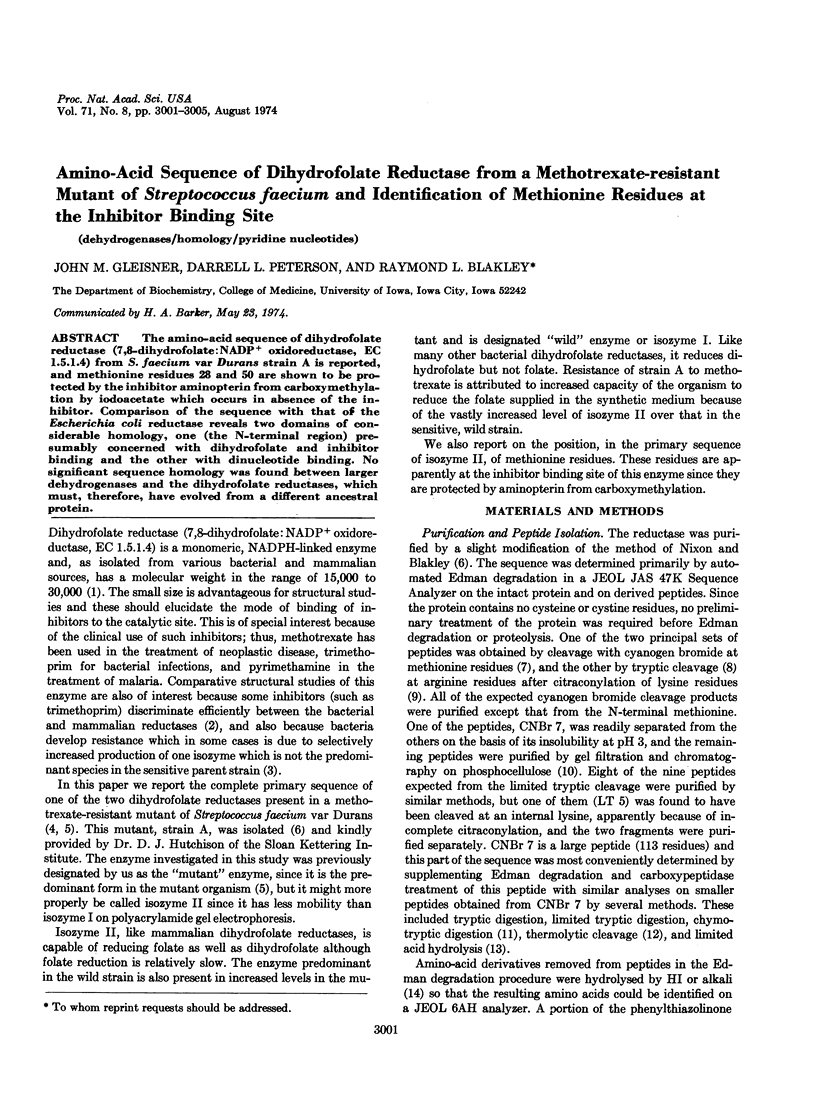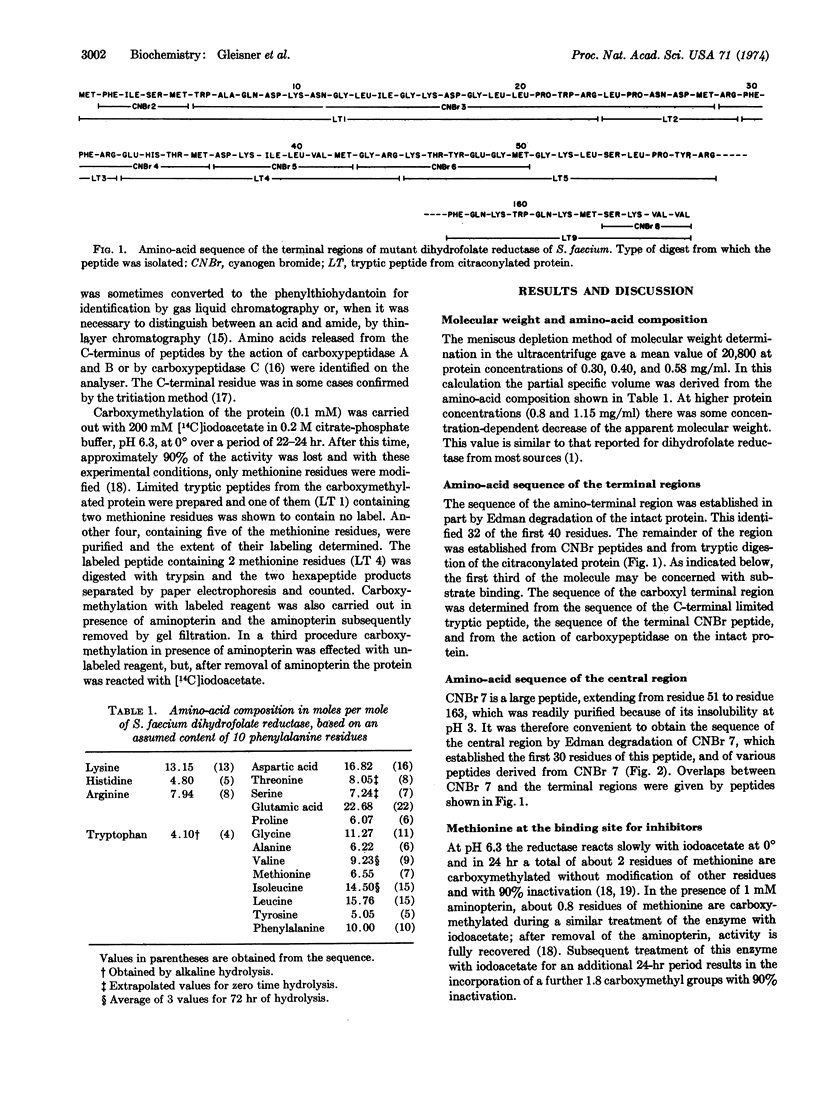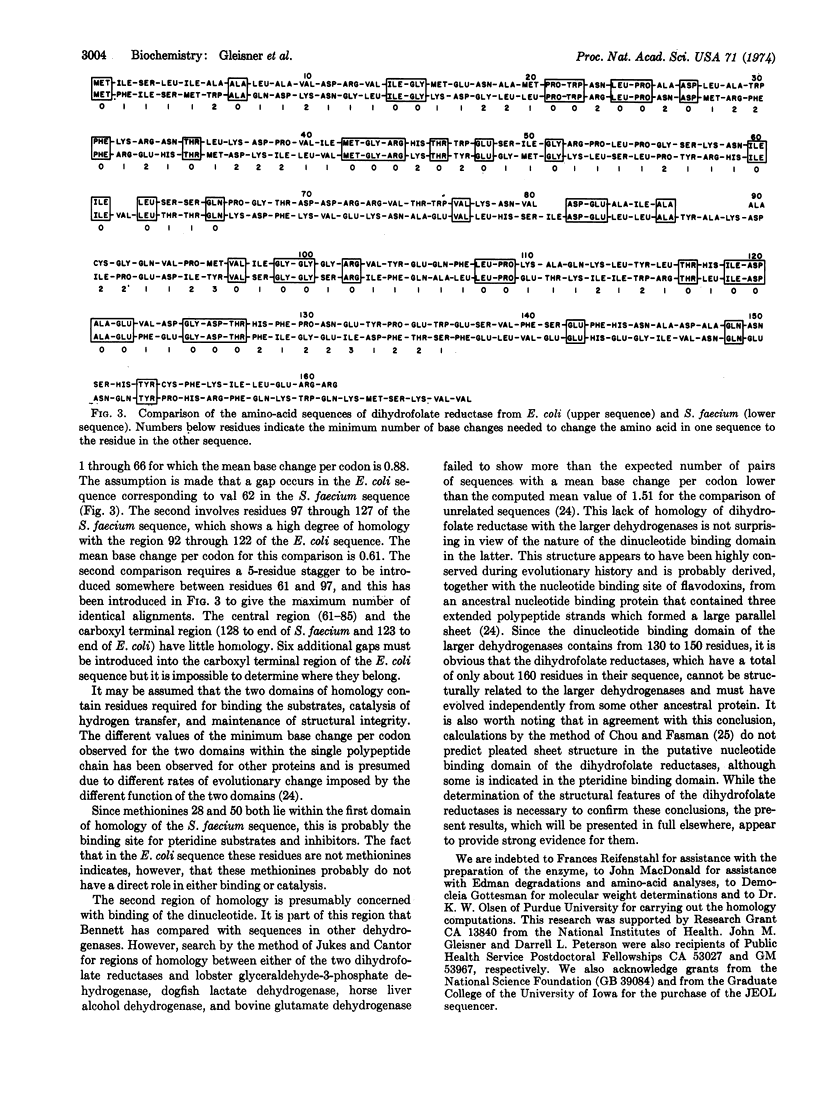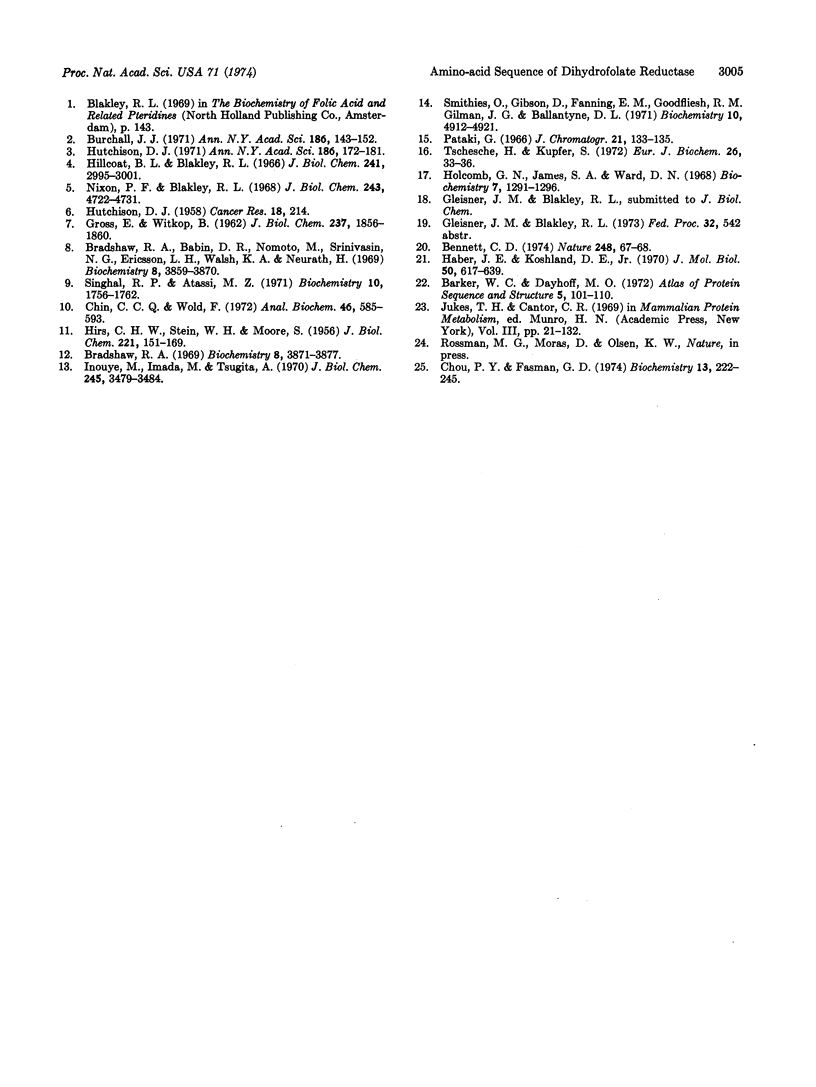Abstract
The amino-acid sequence of dihydrofolate reductase (7,8-dihydrofolate:NADP+ oxidoreductase, EC 1.5.1.4) from S. faecium var Durans strain A is reported, and methionine residues 28 and 50 are shown to be protected by the inhibitor aminopterin from carboxymethylation by iodoacetate which occurs in absence of the inhibitor. Comparison of the sequence with that of the Escherichia coli reductase reveals two domains of considerable homology, one (the N-terminal region) presumably concerned with dihydrofolate and inhibitor binding and the other with dinucleotide binding. No significant sequence homology was found between larger dehydrogenases and the dihydrofolate reductases, which must, therefore, have evolved from a different ancestral protein.
Keywords: dehydrogenases, homology, pyridine nucleotides
Full text
PDF




Selected References
These references are in PubMed. This may not be the complete list of references from this article.
- Bennett C. D. Similarity in the sequence of Escherichia coli dihydrofolate reductase with other pyridine nucleotide-requiring enzymes. Nature. 1974 Mar 1;248(5443):67–68. doi: 10.1038/248067a0. [DOI] [PubMed] [Google Scholar]
- Bradshaw R. A., Babin D. R., Nomoto M., Srinivasin N. G., Ericsson L. H., Walsh K. A., Neurath H. The amino acid sequence of bovine carboxypeptidase A. II. Tryptic and chymotryptic peptides of the cyanogen bromide fragment F-III. Biochemistry. 1969 Sep;8(9):3859–3871. doi: 10.1021/bi00837a052. [DOI] [PubMed] [Google Scholar]
- Bradshaw R. A. The amino acid sequence of bovine carboxypeptidase A. 3. Biochemistry. 1969 Sep;8(9):3871–3877. doi: 10.1021/bi00837a053. [DOI] [PubMed] [Google Scholar]
- Burchall J. J. Comparative biochemistry of dihydrofolate reductase. Ann N Y Acad Sci. 1971 Nov 30;186:143–152. doi: 10.1111/j.1749-6632.1971.tb46965.x. [DOI] [PubMed] [Google Scholar]
- Chin C. C., Wold F. A convenient method for preparative peptide separation. Anal Biochem. 1972 Apr;46(2):585–593. doi: 10.1016/0003-2697(72)90329-6. [DOI] [PubMed] [Google Scholar]
- Chou P. Y., Fasman G. D. Prediction of protein conformation. Biochemistry. 1974 Jan 15;13(2):222–245. doi: 10.1021/bi00699a002. [DOI] [PubMed] [Google Scholar]
- GROSS E., WITKOP B. Nonenzymatic cleavage of peptide bonds: the methionine residues in bovine pancreatic ribonuclease. J Biol Chem. 1962 Jun;237:1856–1860. [PubMed] [Google Scholar]
- HIRS C. H., STEIN W. H., MOORE S. Peptides obtained by chymotryptic hydrolysis of performic acid-oxidized ribonuclease; a partial structural formula for the oxidized protein. J Biol Chem. 1956 Jul;221(1):151–169. [PubMed] [Google Scholar]
- HUTCHISON D. J. Metabolism of resistant mutants of Streptococcus faecalis. I. Isolation and characterization of the mutants. Cancer Res. 1958 Feb;18(2):214–219. [PubMed] [Google Scholar]
- Haber J. E., Koshland D. E., Jr An evaluation of the relatedness of proteins based on comparison of amino acid sequences. J Mol Biol. 1970 Jun 28;50(3):617–639. doi: 10.1016/0022-2836(70)90089-6. [DOI] [PubMed] [Google Scholar]
- Hillcoat B. L., Blakley R. L. Dihydrofolate reductase of Streptococcus faecalis. I. Purification and some properties of reductase from the wild strain and from strain A. J Biol Chem. 1966 Jul 10;241(13):2995–3001. [PubMed] [Google Scholar]
- Holcomb G. N., James S. A., Ward D. N. A critical evaluation of the selective tritiation method of determining C-terminal amino acids and its application to luteinizing hormone. Biochemistry. 1968 Apr;7(4):1291–1296. doi: 10.1021/bi00844a007. [DOI] [PubMed] [Google Scholar]
- Hutchison D. J. Antifolate resistance and the genetic control of dihydrofolate reductase activity. Ann N Y Acad Sci. 1971 Nov 30;186:172–181. doi: 10.1111/j.1749-6632.1971.tb31140.x. [DOI] [PubMed] [Google Scholar]
- Inouye M., Imada M., Tsugita A. The amino acid sequence of T4 phage lysozyme. IV. Dilute acid hydrolysis and the order of tryptic peptides. J Biol Chem. 1970 Jul 25;245(14):3479–3484. [PubMed] [Google Scholar]
- Nixon P. F., Blakley R. L. Dihydrofolate reductase of Streptococcus faicium. II. Purification and some properties of two dihydrofolate reductases from the amethopterin-resistant mutant Streptococcus faecium var. Durans strain A. J Biol Chem. 1968 Sep 25;243(18):4722–4731. [PubMed] [Google Scholar]
- Pataki G. Anwendung der Dünnschichtchromatographie zur Sequenzanalyse von Peptiden. 4. Untersuchungen über den Abbau von Peptiden mit Phenylisothiocyanat. J Chromatogr. 1966 Jan;21(1):133–135. doi: 10.1016/s0021-9673(01)91274-9. [DOI] [PubMed] [Google Scholar]
- Singhal R. P., Atassi M. Z. Immunochemistry of sperm whale of myoglobin. IX. Specific interaction of peptides obtained by cleavage at arginine peptide bonds. Biochemistry. 1971 May 11;10(10):1756–1762. doi: 10.1021/bi00786a004. [DOI] [PubMed] [Google Scholar]
- Smithies O., Gibson D., Fanning E. M., Goodfliesh R. M., Gilman J. G., Ballantyne D. L. Quantitative procedures for use with the Edman-Begg sequenator. Partial sequences of two unusual immunoglobulin light chains, Rzf and Sac. Biochemistry. 1971 Dec 21;10(26):4912–4921. doi: 10.1021/bi00802a013. [DOI] [PubMed] [Google Scholar]
- Tschesche H., Kupfer S. C-terminal-sequence determination by carboxypeptidase C from orange levels. Eur J Biochem. 1972 Mar 15;26(1):33–36. doi: 10.1111/j.1432-1033.1972.tb01735.x. [DOI] [PubMed] [Google Scholar]


